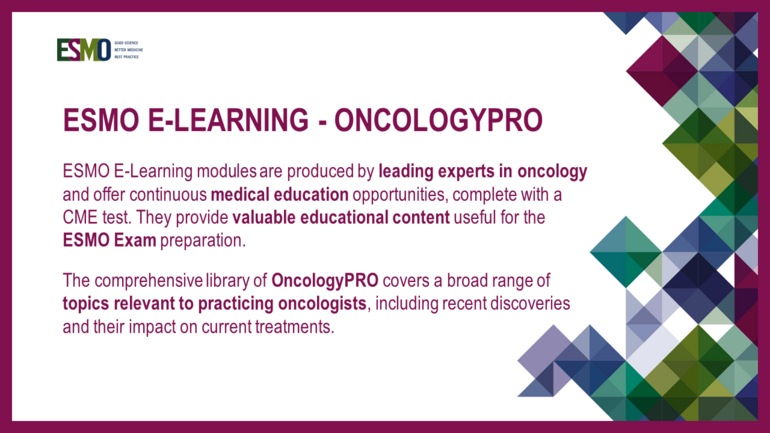This E-Learning module is an update of the previous ESMO module on diagnosis, biology, prognosis and management of patients with mantle cell lymphoma (MCL). The module provides an excellent overview of findings from clinical trials and puts into context the novelties from studying the new agents in first-line and treatment at relapse occurring in different settings of patients with MCL.
MCL accounts for approximately 6% of all non-Hodgkin lymphoma cases. Median age at diagnosis is 60-70 years and there is a male predominance with disease affecting more men than women. Extranodal disease manifestation is very frequent. Since its worldwide recognition in 1994, it has been known for having a dismal prognosis with a median overall survival of 3 years only.
In terms of first-line treatment, the authors emphasize that watch and wait strategy in some patients with indolent, low tumour burden MCL is possible, while most patients will need up-front therapy. Induction-regimens containing high-dose cytarabine improve progression-free survival (PFS) and overall survival (OS), as well as minimal residual disease negativity. High-dose chemotherapy, followed by autologous stem cell transplantation (ASCT) prolongs PFS and OS and is currently the standard of care for younger patients. Rituximab maintenance every 2 months for 3 years after ASTC improves OS.
In terms of first-line treatment for elderly patients with MCL, the authors emphasize that bortezomib in combination with R-CAP shows better PFS and OS compared to R-CHOP and is a good option for aggressive (e.g. blastoid) MCL. Bendamustin in combination with rituximab can be applied with comparable overall response rate and OS as R-CHOP, but with fewer side effects. Adding ibrutinub to bendamustine and rituximab achieves longer PFS and time to next treatment. Rituximab as maintenance therapy every 2 months following R-CHOP or bendamustine/rituximab significantly improves PFS. Maintenance with rituximab/lenalidomide for 2 years following alternating courses of R-CHOP/R-high-dose-cytarabine prolongs PFS.
In terms of treatment at relapse, the authors emphasize that immuno-chemotherapy is a preferred option in relapses occurring after long remissions, depending on patient fitness, age, comorbidities, and earlier therapy. Bruton’s tyrosine kinase (BTK) inhibition in case of early relapse is superior to salvage immuno-chemotherapy. Lenalidomide with or without rituximab also achieves ongoing responses. In post-BTK relapse, CAR T-cells offers a new standard of care for eligible patients.
Furthermore, in case of treatment at relapse, the authors underline that rituximab maintenance after salvage immunochemotherapy leads to improved PFS. If high-dose chemotherapy and ASCT has not been offered in first-line treatment, eligible patients should be offered this option after lymphoma remission in relapse. Young, fit patients with relapse after high-dose chemotherapy and ASCT should be offered an allogenic transplantation if a donor is available. New agents, such as the bispecific antibody glofitamab and non-covalent BTK inhibitors, such as pirtubrutinib, achieve ongoing remissions after failure of BTK inhibitor.
Tobias Weiglein has no interests to declare
Martin Dreyling has reported:
Financial interests:
AstraZeneca, Bayer BMS/Celgene, Beigene, Genmab, Gilead, Incyte, Janssen, Novartis, Roche, Lilly/Loxo, Morphosys: Advisory Board, Personal, Scientific Advisory Board.
Amgen, Bayer, Celgene, Janssen, Roche, AstraZeneca, Gilead/Kite, Incyte, Novartis: Invited Speaker, Personal, Speaker's honoraria.
AbbVie, Bayer, Celgene, Janssen, Roche: Research Grant, Institutional, Academic Trial.



